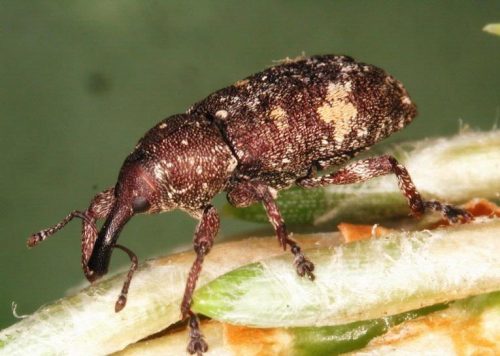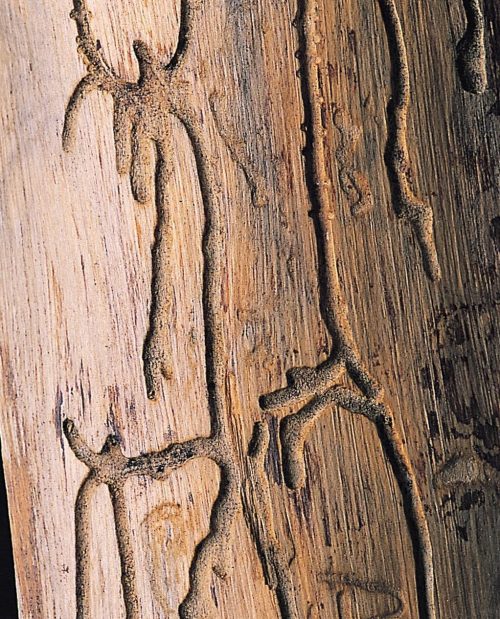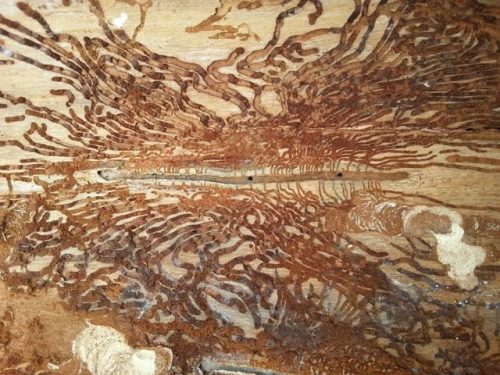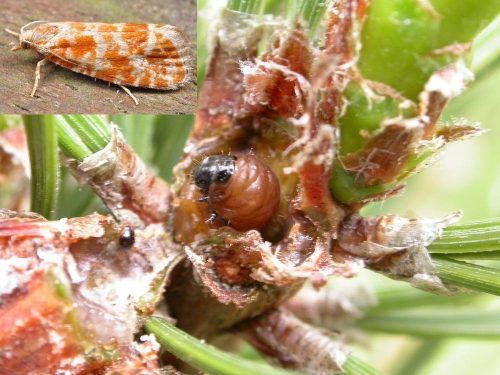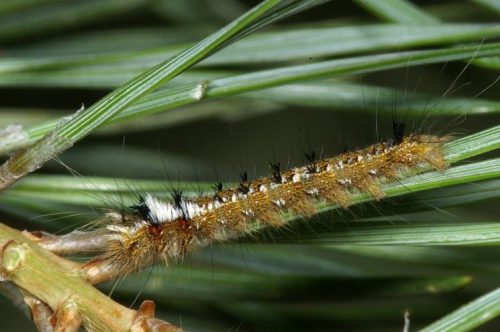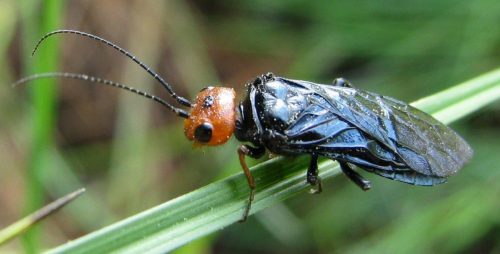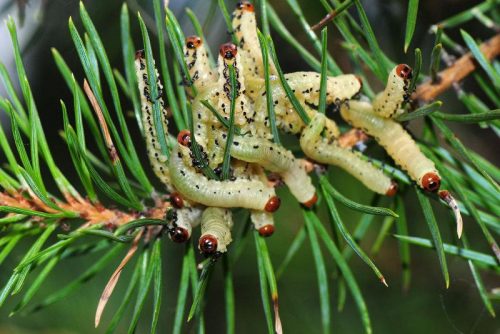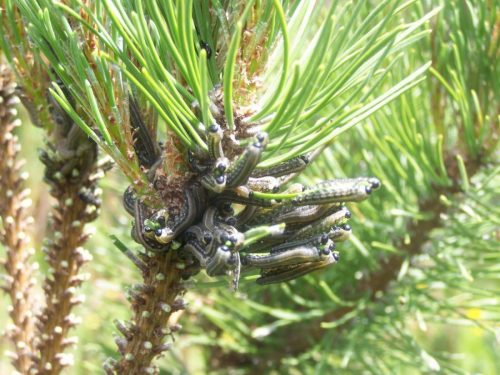Pine trees, pest information and treatment
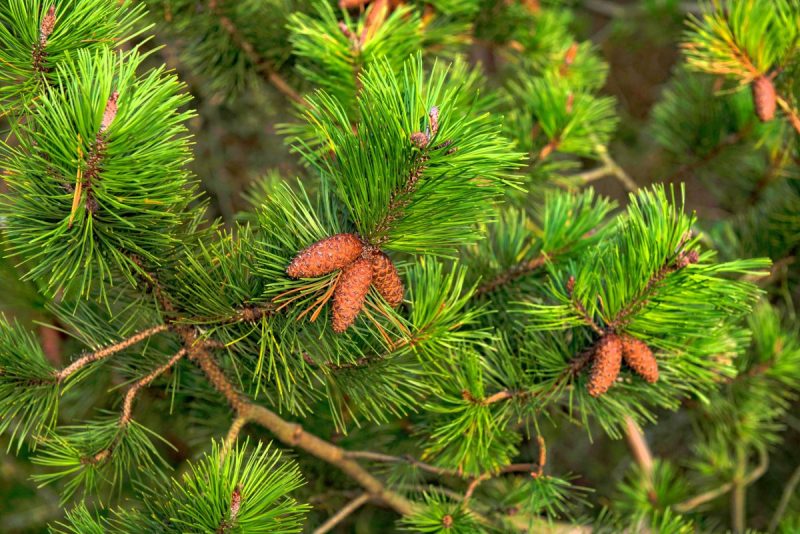
Pissodes notatus – lesser banded pine weevil
These pine pests are also known as the ‘minor pine weevil’, preferring young pine trees with thin bark.
Biology. It has one generation a year, flying from spring to autumn. It overwinters in the adult stage in the cracks of the bark or the litter, less often in the larval stage.
The attack. The larvae gnaw irregular descending galleries between the bark and the wood. The pupation spot is deeply imprinted on the wood. Each young beetle gnaws a round exit hole for the flight. The attacked trees have reddish needles and resin leaks are observed on the trunks.
Control methods. Mechanical pest control is done by extracting and destroying the attacked trees when the insects are still in the larval or pupal stage. For young pine stands, treatments with systemic or contact insecticides are performed. In the egg or larval stage, insect growth regulators can be applied.
Recommended products
-
You can find products on a different store
Change Store -
You can find products on a different store
Change Store -
You can find products on a different store
Change Store -
You can find products on a different store
Change Store -
You can find products on a different store
Change Store -
You can find products on a different store
Change Store -
You can find products on a different store
Change Store -
You can find products on a different store
Change Store -
You can find products on a different store
Change Store -
You can find products on a different store
Change Store -
You can find products on a different store
Change Store -
You can find products on a different store
Change Store -
You can find products on a different store
Change Store -
You can find products on a different store
Change Store -
You can find products on a different store
Change Store -
You can find products on a different store
Change Store -
You can find products on a different store
Change Store -
You can find products on a different store
Change Store -
You can find products on a different store
Change Store -
You can find products on a different store
Change Store -
You can find products on a different store
Change Store -
You can find products on a different store
Change Store -
You can find products on a different store
Change Store -
You can find products on a different store
Change Store
Pissodes validirostris – pine cone weevil
The insect attacks the cones of different species of Pinus but especially those of Pinus sylvestris. Sometimes it also attacks spruce cones.
Biology. It has one generation per year or one generation every 2 years, with the flight in May. It overwinters in the adult stage in the litter or the cracks of the bark, less often in the larvae stage.
The attack. The first damages are produced in May when the beetles (adults) gnaw the young cones. Resin leaks from the attacked cones. After their emergence, the larvae gnaw irregular galleries inside the cone. Yellow-rusty sawdust can be observed on the affected cones. Later, they destroy the seeds and pupate. The round exit holes of the adults can be identified on the damaged cones. The attacked cones do not develop, are covered with resin, have a yellow-gray color, and fall early on the ground. In years with weak cone production, the larvae develop inside the young shoots, causing damage to the trees.
Control methods. Mechanical control is done by gathering fallen cones and destroying them. Chemical control can be performed with systemic or contact insecticides, applied during the flight and in the larval stage.
Recommended products
-
You can find products on a different store
Change Store -
You can find products on a different store
Change Store -
You can find products on a different store
Change Store -
You can find products on a different store
Change Store -
You can find products on a different store
Change Store -
You can find products on a different store
Change Store -
You can find products on a different store
Change Store -
You can find products on a different store
Change Store -
You can find products on a different store
Change Store -
You can find products on a different store
Change Store -
You can find products on a different store
Change Store -
You can find products on a different store
Change Store -
You can find products on a different store
Change Store -
You can find products on a different store
Change Store -
You can find products on a different store
Change Store -
You can find products on a different store
Change Store -
You can find products on a different store
Change Store -
You can find products on a different store
Change Store -
You can find products on a different store
Change Store -
You can find products on a different store
Change Store -
You can find products on a different store
Change Store -
You can find products on a different store
Change Store -
You can find products on a different store
Change Store -
You can find products on a different store
Change Store
Ips sexdentatus – six-toothed bark beetle
It is one of the pests of pine, less often attacking spruce, fir, or larch. Usually, older and weakened trees are attacked, but the beetle can become a primary pest in case of mass multiplications.
Biology. It has 1-2 generations per year, flying in April-May and July-August. It overwinters in the adult stage.
The attack. Adults and larvae gnaw galleries between bark and wood, imprinted on wood. Mating takes place under the bark, in a wider gnawing, called the nuptial chamber. From here, 2-5 vertically oriented mother galleries start, which can be up to 50 cm long. The larval galleries are short. Both the entering holes under the bark and the exit flight holes are round. The attack is manifested in the lower part of the trunk, where the bark is thicker.
Control methods. It is recommended to monitor the pine pests population and detect outbreaks in time. Pheromone-baited and chemically treated trap trees and trap logs are used for monitoring and control. In the egg or larval stage, insecticides or insect growth regulators can be applied.
Recommended products
-
You can find products on a different store
Change Store -
You can find products on a different store
Change Store -
You can find products on a different store
Change Store -
You can find products on a different store
Change Store -
You can find products on a different store
Change Store -
You can find products on a different store
Change Store -
You can find products on a different store
Change Store -
You can find products on a different store
Change Store -
You can find products on a different store
Change Store -
You can find products on a different store
Change Store -
You can find products on a different store
Change Store -
You can find products on a different store
Change Store -
You can find products on a different store
Change Store -
You can find products on a different store
Change Store -
You can find products on a different store
Change Store -
You can find products on a different store
Change Store -
You can find products on a different store
Change Store -
You can find products on a different store
Change Store -
You can find products on a different store
Change Store -
You can find products on a different store
Change Store -
You can find products on a different store
Change Store -
You can find products on a different store
Change Store -
You can find products on a different store
Change Store -
You can find products on a different store
Change Store
Ips acuminatus – sharp-toothed bark beetle
In the case of large pine trees, the sharp-toothed bark beetle attacks mainly the top of the tree and the thin branches. Young trees can be completely attacked. The insect is rarely found on spruce and larch.
Biology. It has one generation a year, flying in May-June.
The attack. The females gnaw mother-galleries between the bark and the wood, usually in four directions from the nuptial chamber. Sometimes up to 10 females can gnaw in different directions from a single nuptial chamber, so the imprint of the attack is star-shaped. The larval galleries are short, sinuous, and spaced apart.
Control methods. It is essential to detect in time the mass multiplication of insects, through in-flight observations and damage monitoring. Pheromone-baited and chemically treated trap trees and trap logs can be used. In case of a severe attack, the use of insecticides (contact, ingestion, systemic) is recommended.
Recommended products
-
You can find products on a different store
Change Store -
You can find products on a different store
Change Store -
You can find products on a different store
Change Store -
You can find products on a different store
Change Store -
You can find products on a different store
Change Store -
You can find products on a different store
Change Store -
You can find products on a different store
Change Store -
You can find products on a different store
Change Store -
You can find products on a different store
Change Store -
You can find products on a different store
Change Store -
You can find products on a different store
Change Store -
You can find products on a different store
Change Store -
You can find products on a different store
Change Store -
You can find products on a different store
Change Store -
You can find products on a different store
Change Store -
You can find products on a different store
Change Store -
You can find products on a different store
Change Store -
You can find products on a different store
Change Store -
You can find products on a different store
Change Store -
You can find products on a different store
Change Store -
You can find products on a different store
Change Store -
You can find products on a different store
Change Store -
You can find products on a different store
Change Store -
You can find products on a different store
Change Store
Tomicus piniperda – pine shoot beetle
It is also known as the ‘Japanese pine engraver’ or the ‘larger pith borer’. These insects prefer Scots pine trees with thick trunks and thick bark, but they also attack fir and larch trees. It is considered a primary pest by the damage produced to shoots, and a secondary pest by the damages produced to cones and the base of the trunks.
Biology. It usually has one generation a year. A sister brood is sometimes observed. The flight takes place in March-April, sometimes in May. The insect overwinters as an adult in the galleries gnawed at the base of the attacked trunk or in the litter.
The attack. Females gnaw vertically oriented single-parent galleries (monogamous species), between bark and wood. The larvae gnaw galleries perpendicularly to the mother gallery (except for the extremities of the mother gallery, where the larval galleries are oriented almost vertically). Young beetles gnaw galleries in the axis of the annual or one-year-old shoots. In spring, the adults gnaw further in the axis of the attacked shoots. These shoots and branches dry out and break (sometimes under the action of the wind).
Control methods. Pheromone-baited and chemically treated trap trees and trap logs are used for monitoring and controlling these pine pests. Systemic or contact insecticides may be also used. Insect growth regulators can be applied in the egg or larval stage.
Recommended products
-
You can find products on a different store
Change Store -
You can find products on a different store
Change Store -
You can find products on a different store
Change Store -
You can find products on a different store
Change Store -
You can find products on a different store
Change Store -
You can find products on a different store
Change Store -
You can find products on a different store
Change Store -
You can find products on a different store
Change Store -
You can find products on a different store
Change Store -
You can find products on a different store
Change Store -
You can find products on a different store
Change Store -
You can find products on a different store
Change Store -
You can find products on a different store
Change Store -
You can find products on a different store
Change Store -
You can find products on a different store
Change Store -
You can find products on a different store
Change Store -
You can find products on a different store
Change Store -
You can find products on a different store
Change Store -
You can find products on a different store
Change Store -
You can find products on a different store
Change Store -
You can find products on a different store
Change Store -
You can find products on a different store
Change Store -
You can find products on a different store
Change Store -
You can find products on a different store
Change Store
Tomicus minor – lesser pine shoot beetle
It is also known as ‘small pine engraver’ or ‘minor pith borer’ and it attacks mostly pine trees with thin bark.
Biology. It has one generation per year, flying in March-April. It overwinters as an adult.
The attack. The females chew mother galleries between the bark and the wood, starting in pairs from a nuptial chamber, in opposite directions. The imprinted gnawing is similar to a horizontal accolade. Larval galleries are up to 3 cm long, and pupation takes place in the wood. At the end of each larval gallery, the entry hole for pupation can be observed.
Control methods. As with other species of bark beetles, it is recommended to monitor the pine pests population and detect in time an eventual mass multiplication. This can be done by observing the adults during the flight and the produced damages, and by using trap trees and trap logs. The latter can also be used for pest control. In addition, the use of systemic or contact insecticides can be taken into consideration.
Recommended products
-
You can find products on a different store
Change Store -
You can find products on a different store
Change Store -
You can find products on a different store
Change Store -
You can find products on a different store
Change Store -
You can find products on a different store
Change Store -
You can find products on a different store
Change Store -
You can find products on a different store
Change Store -
You can find products on a different store
Change Store -
You can find products on a different store
Change Store -
You can find products on a different store
Change Store -
You can find products on a different store
Change Store -
You can find products on a different store
Change Store -
You can find products on a different store
Change Store -
You can find products on a different store
Change Store -
You can find products on a different store
Change Store -
You can find products on a different store
Change Store -
You can find products on a different store
Change Store -
You can find products on a different store
Change Store -
You can find products on a different store
Change Store -
You can find products on a different store
Change Store -
You can find products on a different store
Change Store -
You can find products on a different store
Change Store -
You can find products on a different store
Change Store -
You can find products on a different store
Change Store
Rhyacionia buoliana – European pine shoot moth
It is a defoliating species in nurseries and young pine plantations (6-15 years). It chews the young needles and buds. Scots pine is the main host.
Biology. It develops one generation a year, with the flight in June-July, during the evening. It overwinters in the larval stage, inside the buds.
The attack. The newly hatched larvae chew the base of the needles, which turn yellow after the attack. Then, larvae tie with silk threads the two lateral buds from the top of the shoot. They penetrate one of the buds and overwinter inside. These buds are partially covered by resin leaks. In spring, the larvae attack the axis of the shoots. Pupation takes place here. The shoots turn brown, bend, and dry.
Control methods. The attack is detected in spring by observing the attacked, deformed, or dry vines. In autumn, the white resin leaks can be observed on the buds. Mechanical control consists in gathering and burning the attacked shoots (in which the larvae are hidden). Systemic insecticides can be applied in the larval or adult stage. Contact insecticides can be applied during the flight. Insect growth regulators can be applied in the egg or larval stage.
Recommended products
-
You can find products on a different store
Change Store -
You can find products on a different store
Change Store -
You can find products on a different store
Change Store -
You can find products on a different store
Change Store -
You can find products on a different store
Change Store -
You can find products on a different store
Change Store -
You can find products on a different store
Change Store -
You can find products on a different store
Change Store -
You can find products on a different store
Change Store -
You can find products on a different store
Change Store -
You can find products on a different store
Change Store -
You can find products on a different store
Change Store -
You can find products on a different store
Change Store -
You can find products on a different store
Change Store -
You can find products on a different store
Change Store -
You can find products on a different store
Change Store -
You can find products on a different store
Change Store -
You can find products on a different store
Change Store -
You can find products on a different store
Change Store -
You can find products on a different store
Change Store -
You can find products on a different store
Change Store -
You can find products on a different store
Change Store -
You can find products on a different store
Change Store -
You can find products on a different store
Change Store
Dendrolimus pini – pine-tree lappet moth
It is also known as ‘pine lasiocampid’, or simply as ‘pine moth’. The presence of these pine pests has been reported in pine forests and on weakened isolated trees.
Biology. The species usually develops one generation per year, rarely one generation every two years. The flight is performed by the adults in June-July, in the evening. Pine lappet moths overwinter in the larval stage, gathered together in the litter. After the snow melts, the larvae climb back into the crown of the trees.
The attack. In the spring, larvae feed intensely, gnaw buds, young needles, and shoots. The attack starts from the base of the crown and advances towards the top, from the inside of the crown to the outside. Spring attack is the most dangerous and can induce irreversible drought of trees. Larvae cause less damage in late summer.
Control methods. It is recommended to create mixed forest stands and protect the useful entomofauna. In spring, before the larvae climb into the crown, sticky trap rings can be placed on the trunk of the trees. Chemical treatments can be performed with systemic or contact insecticides.
Recommended products
-
You can find products on a different store
Change Store -
You can find products on a different store
Change Store -
You can find products on a different store
Change Store -
You can find products on a different store
Change Store -
You can find products on a different store
Change Store -
You can find products on a different store
Change Store -
You can find products on a different store
Change Store -
You can find products on a different store
Change Store -
You can find products on a different store
Change Store -
You can find products on a different store
Change Store -
You can find products on a different store
Change Store -
You can find products on a different store
Change Store -
You can find products on a different store
Change Store -
You can find products on a different store
Change Store -
You can find products on a different store
Change Store -
You can find products on a different store
Change Store -
You can find products on a different store
Change Store -
You can find products on a different store
Change Store -
You can find products on a different store
Change Store -
You can find products on a different store
Change Store -
You can find products on a different store
Change Store -
You can find products on a different store
Change Store -
You can find products on a different store
Change Store -
You can find products on a different store
Change Store
Acantholyda erythrocephala – pine false webworm
It is also known as ‘pine web-spinning sawfly’ or ‘steel-blue sawfly’. Such pine pests have been reported mostly in young pine forests.
Biology. It has one generation per year and overwinters in the larval stage, in the litter or in the soil.
The attack. Damage is caused by the larvae, which feed on the young pine needles. The attacked trees lose their vigour, become weakened, and are susceptible to diseases or to bark beetle attacks.
Control methods. Chemical treatments can be applied in the larval stage.
Recommended products
-
You can find products on a different store
Change Store -
You can find products on a different store
Change Store -
You can find products on a different store
Change Store -
You can find products on a different store
Change Store -
You can find products on a different store
Change Store -
You can find products on a different store
Change Store -
You can find products on a different store
Change Store -
You can find products on a different store
Change Store -
You can find products on a different store
Change Store -
You can find products on a different store
Change Store -
You can find products on a different store
Change Store -
You can find products on a different store
Change Store -
You can find products on a different store
Change Store -
You can find products on a different store
Change Store -
You can find products on a different store
Change Store -
You can find products on a different store
Change Store -
You can find products on a different store
Change Store -
You can find products on a different store
Change Store -
You can find products on a different store
Change Store -
You can find products on a different store
Change Store -
You can find products on a different store
Change Store -
You can find products on a different store
Change Store -
You can find products on a different store
Change Store -
You can find products on a different store
Change Store
Diprion pini – pine sawfly
The presence of these pine pests is reported throughout Europe. The insect produces partial or total defoliation. It prefers well-lit forest stands with old and weakened trees.
Biology. It has two generations a year, with the flight in May and August. It overwinters in the pupa stage (in the litter), sometimes in the larval stage.
The attack. It mainly attacks 40-100 years old pine trees, less often young trees. The larvae feed on the needles, which curl up, turn yellow, and dry out. The attack can also result in the complete drought of the tree.
Control methods. It is recommended to avoid the establishment of pure pine stands. Pheromone-baited and chemically treated trap trees and trap logs are used for monitoring and control. Chemical treatments are performed during the flight and in the larval stage, with contact and ingestion insecticides. The pest has many natural predators and parasites that should be protected (eg. birds, insects).
Recommended products
-
You can find products on a different store
Change Store -
You can find products on a different store
Change Store -
You can find products on a different store
Change Store -
You can find products on a different store
Change Store -
You can find products on a different store
Change Store -
You can find products on a different store
Change Store -
You can find products on a different store
Change Store -
You can find products on a different store
Change Store -
You can find products on a different store
Change Store -
You can find products on a different store
Change Store -
You can find products on a different store
Change Store -
You can find products on a different store
Change Store -
You can find products on a different store
Change Store -
You can find products on a different store
Change Store -
You can find products on a different store
Change Store -
You can find products on a different store
Change Store -
You can find products on a different store
Change Store -
You can find products on a different store
Change Store -
You can find products on a different store
Change Store -
You can find products on a different store
Change Store -
You can find products on a different store
Change Store -
You can find products on a different store
Change Store -
You can find products on a different store
Change Store -
You can find products on a different store
Change Store
Neodiprion sertifer – European pine sawfly
It is also known as the ‘fox-colored sawfly’ or the ‘lesser pine sawfly’. Pests cause damage to young pine trees (generally up to 20 years old). Prefers Eastern white pine and Scots pine.
Biology. The insect has one generation per year, with the flight in August-September. It overwinters in the egg stage, on the pine needles.
The attack. The larvae chew the needles. Sometimes only the base of the needle remains on the shoots. In case of a severe attack, the larvae can also chew the tip of the young shoots. Repeated defoliation results in the complete drought of the tree.
Control methods. It is recommended to avoid the establishment of pure pine stands. On small surfaces, larvae (from the needles) and pupae (from the litter) can be gathered and destroyed. Pheromone-baited and chemically treated trap trees and trap logs are used for monitoring and control. Chemical treatments are done during the flight, with contact or systemic insecticides. Contact, ingestion, or systemic insecticides can be used to control larvae. The insect has many natural predators and parasites that need to be protected.
Recommended products
-
You can find products on a different store
Change Store -
You can find products on a different store
Change Store -
You can find products on a different store
Change Store -
You can find products on a different store
Change Store -
You can find products on a different store
Change Store -
You can find products on a different store
Change Store -
You can find products on a different store
Change Store -
You can find products on a different store
Change Store -
You can find products on a different store
Change Store -
You can find products on a different store
Change Store -
You can find products on a different store
Change Store -
You can find products on a different store
Change Store -
You can find products on a different store
Change Store -
You can find products on a different store
Change Store -
You can find products on a different store
Change Store -
You can find products on a different store
Change Store -
You can find products on a different store
Change Store -
You can find products on a different store
Change Store -
You can find products on a different store
Change Store -
You can find products on a different store
Change Store -
You can find products on a different store
Change Store -
You can find products on a different store
Change Store -
You can find products on a different store
Change Store -
You can find products on a different store
Change Store














































































































































































































































































































































































































































